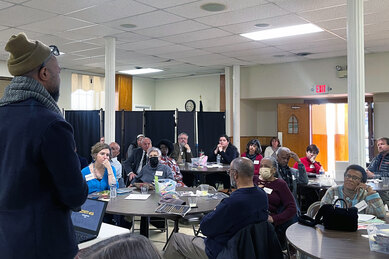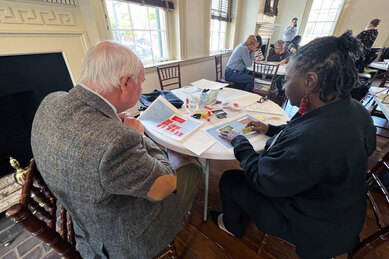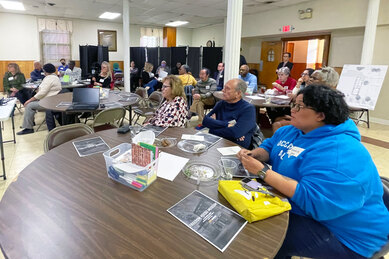Building Trust: A Framework for Traumatic Heritage Sites
"Without facts, you cannot have truth. Without truth, you cannot have trust."
- Maria Ressa, How to Stand Up to a Dictator: The Fight for Our Future
As designers, we are not merely creating physical environments; we are shaping experiences that can either deepen healing or unintentionally widen wounds. Our responsibility is to approach our work with humility, curiosity, and an unwavering commitment to honoring the stories and communities connected to these spaces. This requires moving away from traditional top-down design methods toward co-creation, transparency, and accountability, ensuring that interpretation is rooted in lived experience and collective memory.
Designing with Trust and Trusting Design
Trust is the foundation of any effort to authentically interpret historic sites, particularly those rooted in trauma and resilience. Without trust, narratives risk becoming diluted, performative or disconnected from the lived experiences they seek to honor. Building trust requires more than simply organizing a community workshop—it demands a sustained commitment to authenticity, integrity and healing.
As designers we have a particular responsibility in the trust building process. Trust cannot be assumed simply because a project has noble intentions. It must be earned through a sustained commitment to authenticity, transparency and accountability. Trust demands that we move at the speed of relationship building, not at the speed of deliverables. It requires that we listen deeply, act responsibly and continually check our biases and assumptions throughout the design journey.
Authentic interpretation starts with centering the truth. Communities connected to these sites carry deep histories, often marked by pain, perseverance and erasure. Without their voices leading the process, interpretation risks replicating the very harms it seeks to illuminate. As designers it is not our role to "give" voice to communities, but to amplify the voices already present.
Integrity demands that interpretation be free from distortion or sanitization, even when histories are uncomfortable. Visitors can discern when narratives are curated to avoid discomfort rather than foster understanding. Trust ensures that sites remain spaces where the realities of trauma are acknowledged and resilience is honored without spectacle or exploitation.
Healing is an essential outcome of the design process for such sites. Historic sites have the potential to serve as spaces of reckoning and restoration, but only if the process is anchored in trust. Healing cannot be forced or manufactured; it grows when communities feel their stories are handled with care, respect, and accountability providing a positive and restorative path forward.
Ultimately, trust transforms interpretation from a technical exercise into a shared act of cultural stewardship. It enables sites of trauma and resilience to become living spaces—spaces where past and present meet, where memory is preserved with dignity, and where visitors are invited into a deeper, more empathetic understanding of our collective history.

Building trust in the design process requires more than simply organizing a community workshop—it demands a sustained commitment to authenticity, integrity and healing.
Engaging Descendant Communities
Descendant communities are not passive observers of history but active stewards of memory. Their engagement in designing spaces that interpret sites of trauma and resilience is not just a matter of inclusion; it’s a matter of truth, justice and healing. These communities carry the living memory of the past; their stories, emotions, and perspectives are vital to shaping accurate and humane narratives. Without their voices, we risk designing spaces that are sterile, or even harmful, reducing complex histories to watered-down abstract experiences.
Descendant communities offer insight into the generational impact of trauma and the endurance of resilience. Central to this engagement is genealogical research, which is an act of reclaiming names, lives, and legacies often erased or silenced. Through genealogy, descendants trace not only bloodlines but stories of survival, resistance, and connection, deepening our collective understanding of the past. Increasingly, descendant communities are advocating for dedicated genealogical research spaces, where designers play a crucial role in shaping inclusive environments that honor memory, invite discovery, and support healing. When a community can see their ancestors represented, not as statistics, but as individuals with identities and agency, these spaces become more than memorial. They become a bridge between generations, transforming sites of pain into places of power, where remembrance leads to understanding and understanding into action.
By incorporating descendant voices coupled with genealogical knowledge, we create spaces that are emotionally resonant and historically grounded. It fosters a sense of belonging and accountability, where interpretation becomes a collaborative act of truth-telling. Ultimately, these partnerships help reimagine cultural memory as something shared and restorative, rather than something imposed and incomplete.

Without descendant voices, we risk designing spaces that are sterile, or even harmful, reducing complex histories to watered-down abstract experiences.
Listening to Community Voices
Designing for sites of trauma and resilience requires a robust community engagement process, engaging members of relevant communities, building trust with them, and translating their salient concerns into a design solution that truly reflects their complexities. The critical first step is assembling key members of this community that represent their range of voices. Working with our clients, we help identify these members so that neighbors, academics, activists, students, professionals, descendants and others have a seat at the table.
After assembling an engagement group of a manageable size (up to 30 people), the next key step is to plan a transparent process that encourages active listening. A regular schedule of touch points with strategic activities planned well in advance ensures as much participation as possible. This is not simply a community workshop as that tends to be an isolated activity that does not provide continuity to dig deeper into true community issues. Rather, engagement activities should be rolled out in a series to allow for initial ice-breaking that gradually leads to revealing deeper and more intimate feelings and ideas about history, site, community and progress. For example, while planning the rehabilitation of Freedom House in Alexandria, Virginia, activities at initial sessions were planned to get people out of their seats and engaging with each other as much as with the facilitator, allowing for more authentic conversations. The later sessions then built upon the specific responses from the previous sessions to build ongoing momentum and trust and to allow for deeper and more revealing content.
To yield the most informative results from community engagement, a seasoned facilitator that is reflective of the engaged community is critical. Their role is to assist the design team with balancing the voices in the room. Engagement activities, particularly when addressing painful or traumatic histories, evoke passionate responses where some participants may grandstand and dominate the conversation. We have found engagement is more successful when the reserved voices are intentionally invited and elevated alongside active moderation of more outspoken voices.
Additionally, because a successful engagement process requires multiple touch points with a participating community, and participants often may not repeat from session to session, mitigating the changing dynamics of changing participants is critical. Therefore, trying to bring the community along requires providing base information for all participants so that all are working from similar date points of conversation. One method we utilized during the renovation of the Philodemic Room at Georgetown University, is creating a primer to provide base history and resources about the space so that participants were all starting with a similar understanding.

Engagement activities with the community should be programmed in a series to allow for initial ice-breaking that gradually leads to revealing deeper and more intimate feelings and ideas about history, site, community and progress.
Trust is not a one-time achievement—it is a continuous act of care, accountability, and listening. Design rooted in trust transforms memory into shared stewardship, honoring both the pain and the resilience embedded in these histories. Through this work, we help build a future where truth fosters healing and collective strength.